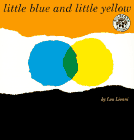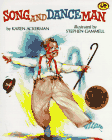Color and Children's Literature
![]()
This article by Carol Otis Hurst first appeared in Teaching PreK-8 Magazine's Library Corner.
![]()
Let's bring color to the library this month.

Bulletin board - Make a large rainbow arc using titles of books against each color or, if you're talented with letter cutting, use the colored letters of the title to make the rainbow arc. Against the red use such titles as My Red Umbrella, The Red Pony and Little Red Riding Hood. For orange use The Big Orange Splot, The Mystery of the Flying Orange Pumpkin, and Oranges and Lemons. Yellow could give you The Yellow House Mystery, Old Yeller, and Yellow and Pink. Green brings to mind Greenwitch, The Green Book, and Green Says Go. For blue you can use A Solitary Blue, The Blue-Eyed Daisy, The Blue Moose, and Bluebear. Purple is harder, but there's The Purple Coat, and the The Purple Cow. If you have a drawing of a large pot of paint at the bottom from which the rainbow appears to come, you can have titles on or in the can which have many colors in them such as Hailstones and Halibut bones, Little Blue and Little Yellow, and Colors. Leave the ends of each color in the rainbow looking as if they were dripping paint and tack a real paint brush near the can. Title the board The Rainbow Connection.
Use Mary O'Neil's Hailstones and Halibut Bones with illustrations by John Wallner (Doubleday, 1989 ISBN 0-385-24485-1. Paperback, Hardcover.) as the starting point for your colorful time in the library. Read the poem for each of the rainbow colors and ask the kids to find other poems which talk about that particular color or about things that are that color. Books with that color in the title are not hard to find, but don't stop there. There are things red such as apples and cherries and you can stay down that road for a whole month easily.
Take the color less literally as O'Neil does and find books to talk about in which characters feel like that color. She says, "Red is feeling brave with all your might." There are many brave characters in children's books: Brave Irene in the book by that name by William Steig (Farrar, 1986 ISBN 0-374-30947-7. Paperback, School & Library Binding, Spanish Paperback, Spanish Hardcover, Cassette.) The Brave Little Tailor, of course, from the fairy tale, but there are many more whose name doesn't include the adjective. There are all those heroes of mythology and legend: King Arthur and his knights, Theseus, Hercules, and Robin Hood, to name a few. Folktales have many brave characters; Rainbow Crow by Nancy Van Laan (Knopf, 1989 ISBN 0-394-99577-5. Paperback) is certainly brave and the name fits so well with this theme.
That's just a start and we've only touched the bravery of red. There's embarrassment and you won't have trouble finding characters who are embarrassed, especially in the novels with a classroom setting. There's the anger of red and you're off in another direction.
Turn to orange because we've got to go on. Orange won't take you half so long. Diane Wolkstein's tale The Magic Orange Tree (Schocken, 1987 ISBN 0-8052-0650-7. Paperback) is a Cinderella variant from Haiti. I'd want to have an orange juice break after that one. Maybe you can compare frozen, fresh and boxed orange juice and do a graph on qualities and preferences for each. Gather an assortment of oranges and compare them in the same ways. Pumpkins are easier. Try Bill Martin, Jr's The Magic Pumpkin (Holt, 1989 ISBN 080501134X. Library Binding).
O'Neil brings up fire and sunset with orange as well as the feeling of saying goodbye. Enough! We've got to move on.

Yellow is easy. There's the man with the yellow hat in the Curious George stories and another much more villainous one in Tuck Everlasting. Besides titles with yellow in them, bananas, lemons, canaries, daffodils and the sun, there's the feelings of yellow. O'Neil talks about the happiness of yellow, but there's the darker side: the cowardice of yellow. Finding cowards in novels and deciding why they behave the way they do is a good subject for character study. The Sheriff of Nottingham is surely a coward and so are the people in Richard Kennedy's Contests at Cowlick (Atlantic, 1975 ISBN 0-316-48863-1). Is Joel Bates in Marion Dane Bauer's On My Honor a coward? Find other examples of cowardly behavior. What makes a person cowardly or brave in any given situation? Is it cowardly to refuse to fight?
Moving on to green, besides the titles with green in them we have things green like growing things, woods, leprechauns, grasshoppers, frogs, and alligators which should keep you busy for a while. I hate to be negative but green makes me think of the green-eyed monster of envy and envious people are not hard to find in children's books. There are the characters who envy someone else's life or possessions until they experience them and then there are wonderfully envious, villanous characters like Aunt Bea in Village by the Sea by Paula Fox (Dell, 1990 ISBN 0-440-40299-9). There's a character study that you can sink your teeth into. Don't forget green expressions such as "The grass is always greener on the other side of the fence", being a greenhorn, and having a green thumb. Each of those can lead you to many books as well as the vocabulary development in the expression itself.
Come on, we've got two colors left. Blue is easy. There's sky and the sea for subjects and there are many titles with blue in them. O'Neil talks about blue being the cold and you certainly won't have trouble finding books about creatures who thrive in cold lands: penguins, polar bears, seals, etc. She says blue is "feeling way down low" and there are many good books which talk about sad times. Everybody knows The Tenth Good Thing About Barney by Judith Viorst (Macmillan, 1971 ISBN 689-71203-0), but don't forget Carol and Donald Carrick's The Accident (Houghton, 1981 ISBN 0-395-28774-X). It isn't only death that makes one feel blue. There's loneliness, misunderstanding, and failure. Children need to talk about their own sad times as well as those of the characters in books. Enough digression on to purple.

Grapes are purple and don't forget "purple mountains' majesty." Shadows are sometimes called purple although they've always looked black to me. People are sometimes said to be purple with rage, but we talked about anger with red. O'Neil talks about purple as the time just before night and Grandfather Twilight by Barbara Berger (Putnam, 1986 ISBN 0-399-20996-4) springs to mind as do all those other picture books about the coming of night. If we talk about the Twilight of the Gods I guess we can talk about human twilight time in connection with purple and that leads us to some delightful books like Song and Dance Man by Karen Ackerman (Knopf, 1988 ISBN 0-394-99330-6).
Don't forget the songs. Those "twilight timers" will be happy to sing you "Deep Purple" and that can lead you to a song fest with grandparents and children matching each other color for color song.
Enjoy the color!
![]()
Related Areas of this Site:
- Little Blue and Little Yellow by Leo Leonni
- Song and Dance Man by Karen Ackerman
Advertisement:
Advertisement:
Advertisement:

